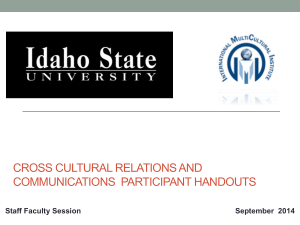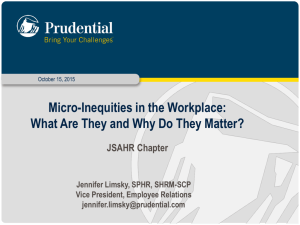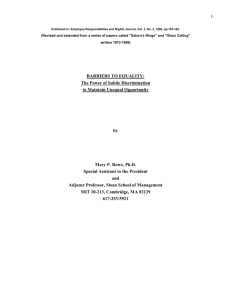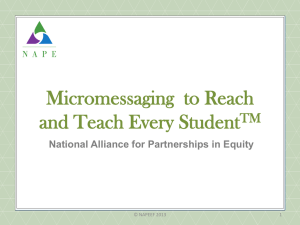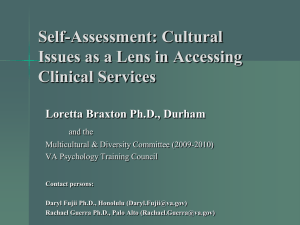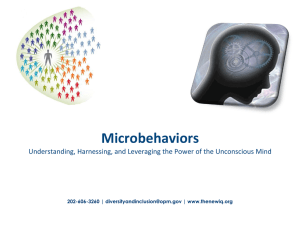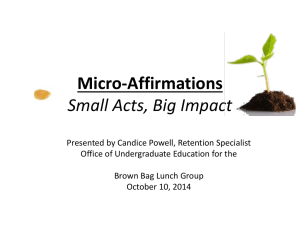Microinequities in the Workplace 082213
advertisement
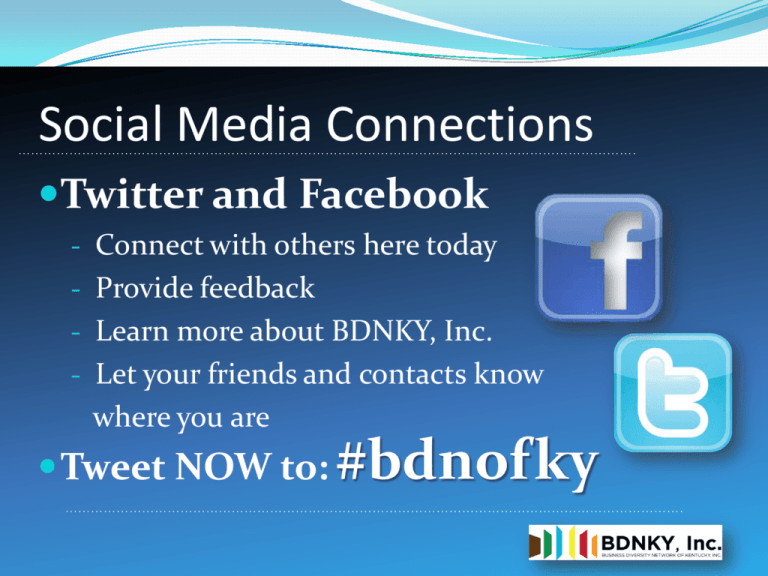
Social Media Connections Twitter and Facebook - Connect with others here today - Provide feedback - Learn more about BDNKY, Inc. - Let your friends and contacts know where you are Tweet NOW to: #bdnofky “When Little Things Become Big Deals” Presented by Toni Rogers Rogers Consulting August 22, 2013 Icebreaker Locate someone you don’t know Share your name/company/role Where in the world you’d like to travel 8/22/2013 3 “It is not our differences that divide us. It is our inability to recognize, accept, and celebrate those differences.” Audrey Lourde 8/22/2013 4 Purpose To raise our awareness of the effects of Micro-Inequities/Micro-Messaging in the workplace. Provide practical techniques to minimize Micro-Inequities /MicroMessaging. 8/22/2013 5 Our Roadmap/GPS What are Micro-Inequities? What it looks like in the workplace. The role of the communication in MicroMessages. The negative impact of Micro-Inequities. Micro-Affirmations—turning things around. Putting it all together. 8/22/2013 6 What Are Micro-Inequities? The phrase was coined by MIT researcher Mary Rowe, PhD, in 1973. Subtle slights and snubs that devalue an employee. Communication interactions that include some and exclude others. Indirect offenses that can demoralize. 8/22/2013 7 Micro-Inequities/Micro-Messages 8/22/2013 8 Examples of Micro-Inequities The person you are talking to continues typing on their computer. Not being acknowledged when passed in the hallway. Not being introduced or ignored during a meeting. Being left out of a project/discussion. Your name repeatedly mispronounced or misspelled. Others? 8/22/2013 9 It’s a small thing, until it happens to you… With your table mates, share an experience of being on the receiving end (or witnessing someone else on the receiving end) of a Micro-Inequity. Discussion questions: 1. How often does this happen? 2. Were you aware of the Micro-Inequity at the time? 3. How did you react and why? 8/22/2013 10 Micro-Inequities “Micro-Inequities are not one time events. They are cumulative and repeated behaviors that devalue, discourage and impair performance in the workplace– and they inevitably affect the overall productivity and health of the company.” Stephen Young, Co-founder and Senior partner of Insight Education Systems 8/22/2013 11 Micro-Messages 8/22/2013 Verbal Non-Verbal Conscious Unconscious Intentional Unintentional Subtle Overt 12 Communication is Key We send between 2000-4000 subtle positive and negative messages a day! What messages are you sending? Body language speaks louder than verbal communication. 8/22/2013 13 “When you speak, ALL OF YOU SPEAKS.” Virgina Satir American Author and Psychotherapist 8/22/2013 14 Our Communication 8/22/2013 Vocabulary/Verbal 7% Voice Inflection/Tone 38% Nonverbal 55% 15 Communications Exercise One of the key components of effective communication is listening. Listen UP! 8/22/2013 16 Listening is Work! Practice being an active listener. Be fully present. 8/22/2013 17 Negative Impact of Micro-Inequities For the Individual For the Company Feeling devalued High turnover Decreased self-esteem Loss of Revenue Feeling like your input is not considered Loss in productivity 8/22/2013 18 Negative Impact of Micro-Inequities For the Individual For the Company Lack of involvement Discrimination complaints Poor interpersonal relationships Feelings of not being listened to 8/22/2013 Poor recruitment Decreased morale 19 Turn it Around From: Micro-Inequities To: Micro-Affirmations 8/22/2013 20 Thoughts to Ponder What gets in the way of your responding (communicating) positively to others in your workplace? What supportive behaviors do you promote in your environment? 8/22/2013 21 What are Micro-Affirmations? “Small acts, both public and private, often unconscious but very effective which occur wherever people wish to help others to succeed. Tiny acts of opening doors of opportunity.” Dr. Mary Rowe 8/22/2013 22 Micro-Affirmations Consistent feedback that builds on strengths and corrects weaknesses. Support and comfort when others are in distress, (e.g., project fell through, missed a major deadline, did not win a project bid). Generous acts of listening. Gestures of inclusion and caring. 8/22/2013 23 Ways to Minimize Micro-Inequities Within your table group, brainstorm ways you can minimize Micro-Inequities. 8/22/2013 24 Ways to Minimize Micro-Inequities Help others feel welcomed; be inclusive. Be aware of the tint of your windows: your biases, stereotypes, prejudices. Learn more about Micro-Inequities and share with others. Be courageous enough to interrupt MicroInequities and turn them into MicroAffirmations. 8/22/2013 25 Benefits of Micro-Affirmations Likely to help a person do well. Consistent, affirmations can be contagious. Lead to raising morale and productivity. Provide a sense of belonging/acceptance. 8/22/2013 26 Take-Aways What are you taking back to your workplace? Be inclusive, be affirming, be aware! 8/22/2013 27 Summary Micro-Inequities are subtle messages that undermine the value of others in the workplace. Our communication, both verbal and nonverbal, are instrumental in sending these messages. Micro-Affirmations—small acts or gestures of caring and inclusion that consciously affirm others— minimize the negative effects of Micro-Inequities. 8/22/2013 28 The conclusion… Inclusion! Draw a circle that’s big enough to include everyone! 8/22/2013 29 NO MICRO-INEQUITIES 8/22/2013 30 Resources Mary P. Rowe, PhD. Micro-Affirmations & Micro Inequities. MIT. 2008. Stephen Young, Insight Education Systems, “The Power of Small.” www.insighteducationsystems.com. Caroline Laguerre-Brown, JD. Equity, Diversity & Inclusion. Johns Hopkins University. 2007. Eric L. Hinton. Microinequities: When Small Slights Lead to Huge Problems in the Workplace. DiversityInc. 2004. David Rabb, MA. Understanding the Power of MicroInequities. 8/22/2013 31
